Introduction
Modernism is a period of literature that began in the late 19th century and continued until the mid-20th century. It was characterised by a rejection of traditional values and conventions, and instead embraced experimentation with form and content. One of the most distinctive features of modernist writing is the use of internal monologue, which has come to be known as ‘stream of consciousness’. This article seeks to explore the role of internal monologue in modernist writing, and to examine its unique characteristics and how it influences the writing style.
Exploring the Role of Internal Monologue in Modernist Writing
Internal monologue is a narrative device used to explore the thoughts and feelings of a character or narrator. It is often used to provide insight into the inner workings of a character’s mind, offering an intimate view of their emotions, motivations, and desires. In modernist writing, it is used to create a more complex and layered narrative, allowing for a deeper exploration of the characters and their relationships to one another.
An analysis of internal monologue in modernist literature reveals a number of key elements that are essential in conveying the desired effect. These include the use of free association and non-linear thought processes, as well as a focus on the subjective experience of the character. The aim is to create a feeling of immediacy and authenticity in the narrative, allowing the reader to gain a better understanding of the characters and their psychological state.
In addition, the use of internal monologue in modernist writing can also be seen as a form of metafiction, as it serves to draw attention to the artifice of the narrative itself. By presenting the thoughts and feelings of the characters in an unmediated way, it creates a sense of intimacy between the reader and the text, blurring the line between reality and fiction.

Examining the Characteristics of Internal Monologue in Modernist Writing
A closer look at how internal monologue influences modernist writing reveals a number of unique characteristics that serve to shape the narrative. These include the use of fragmentary language, the breakdown of conventional grammar and syntax, and the interweaving of different perspectives. All of these elements combine to create a heightened sense of realism, allowing the reader to feel as if they are inside the minds of the characters.
The use of fragmentary language is particularly important in modernist writing, as it allows the writer to convey the chaotic and unpredictable nature of thought. By breaking down sentences into smaller units, the writer is able to capture the fleeting and often contradictory nature of human thought. This creates a more immediate and immersive experience for the reader, as they are able to experience the thoughts of the characters first-hand.
The breakdown of conventional grammar and syntax is also essential in conveying the desired effect. By using unconventional sentence structures and unconventional word order, the writer is able to create a more naturalistic feel to the narrative. This helps to create a sense of immediacy and authenticity, as the reader is able to experience the thoughts of the characters in a more visceral way.
Finally, the interweaving of different perspectives is also an important element of modernist writing. By presenting multiple points of view within the same narrative, the writer is able to create a more complex and nuanced story. This allows the reader to gain a better understanding of the characters and their relationships to one another, as well as providing insights into the inner lives of the characters.
Conclusion
In conclusion, this article has explored the role of internal monologue in modernist writing, and has examined its unique characteristics and how they influence the writing style. It has been shown that the use of internal monologue in modernist writing serves to create a more complex and layered narrative, allowing for a deeper exploration of the characters and their relationships to one another. Furthermore, the use of fragmentary language, the breakdown of conventional grammar and syntax, and the interweaving of different perspectives all help to create a heightened sense of realism, allowing the reader to experience the thoughts of the characters in a more intimate and immediate way.
It is hoped that this article has provided a useful insight into the role of internal monologue in modernist writing, and has shed light on its unique characteristics and how they influence the writing style. Further research into this topic could explore the use of internal monologue in other literary periods and genres, as well as examining its role in contemporary literature.
(Note: Is this article not meeting your expectations? Do you have knowledge or insights to share? Unlock new opportunities and expand your reach by joining our authors team. Click Registration to join us and share your expertise with our readers.)
